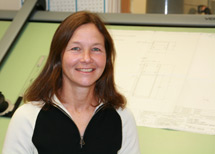
Handy Links
SLAC News Center
SLAC Today
- Subscribe
- Archives: Feb 2006-May 20, 2011
- Archives: May 23, 2011 and later
- Submit Feedback or Story Ideas
- About SLAC Today
SLAC News
Lab News
- Interactions
- Lightsources.org
- ILC NewsLine
- Int'l Science Grid This Week
- Fermilab Today
- Berkeley Lab News
- @brookhaven TODAY
- DOE Pulse
- CERN Courier
- DESY inForm
- US / LHC
SLAC Links
- Emergency
- Safety
- Policy Repository
- Site Entry Form

- Site Maps
- M & O Review
- Computing Status & Calendar
- SLAC Colloquium
- SLACspeak
- SLACspace
- SLAC Logo
- Café Menu
- Flea Market
- Web E-mail
- Marguerite Shuttle
- Discount Commuter Passes
-
Award Reporting Form
- SPIRES
- SciDoc
- Activity Groups
- Library
Stanford
Around the Bay
From the Acting Director of ETS: A Collaboration of Engineering and Technical Teams

The Engineering and Technical Support Directorate has a logo. At first glance this may seem trivial, but the process of creating a logo provided an opportunity for the six unique departments that make up the directorate to consider how we are united around our common goal to support the laboratory. Department heads from the Controls, Klystron, Mechanical Design, Mechanical Fabrication, Metrology, and Power Conversion departments brainstormed to find our unifying concept: "ETS delivers hardware and technology that enables SLAC's science." We asked ETS staff to submit logo ideas. Jim Stanfield of Mechanical Design quickly came up with a winning solution, illustrating progress from nuts and bolts, through technology to delivering science. Barbara Hemstad of ETS Administration and Greg Stewart of InfoMedia Solutions provided the finishing touches.

The departments that make up ETS have been together in one form or another since SLAC's beginning, starting with the Technical Division of Project M—the Stanford University venture that later became the Stanford Linear Accelerator Center. Organizational charts from the 1960s included group names such as Klystron, Microwave Engineering, Modulators, Instrumentation and Control, Mechanical Design and Fabrication, and Electronics. It doesn't take much imagination to see the evolution from those early days to the current departments. Laboratory reorganization in 2005 moved the six departments from the Technical Division into the newly formed Operations Directorate, and restructuring within the past eighteen months created the current ETS Directorate.
While the organizational structure may have changed over the years, the group's ability to work together has not. A collaborative team effort was demonstrated with the design, fabrication, assembly, installation and commissioning of LCLS's electron systems, from the injector vault through the undulator complex and into the beam dump. The Mechanical Design team provided detailed designs using state-of-the-art 3-D CAD modeling tools, and developed a product data management system that provides electronic document management and configuration control for drawings. The Mechanical Fabrication Department used those designs to machine, clean, braze, weld, assemble, bake and install a myriad of components from the most delicate optical devices to multi-ton blocks of marble. MFD, Metrology and Controls worked hand-in-hand to assemble, align and actuate the undulator girders assemblies. Metrology precisely positioned and tuned undulator magnets in the Magnetic Measurement Facility, then carefully aligned the magnets once they were installed in the tunnel. The Klystron and Power Conversion teams played key roles in supplying radio frequency radiation to the injector vault. The Klystron department designed, built and tested the RF gun, phase cavities and X-band klystron as well as the low level RF phase and amplitude controller chassis and RF timing and control chassis. The Power Conversion department designed and built the klystron modulator with a reconfigured pulse forming network for X-band short pulse. They also built and installed many LCLS magnet power supplies and oversaw the installation of miles of new cables and cable trays. The team in Controls contributed the connective links by designing and implementing accelerator control systems software, control room operator interface and physics based high-level application software and feedback systems. They also provided life safety system such as personnel and beam containment safety systems, beam instrumentation and electronic data acquisition for timing system, machine protection system and RF controls.
ETS looks forward to continuing our long tradition of delivering hardware and technology to support SLAC's science mission.
